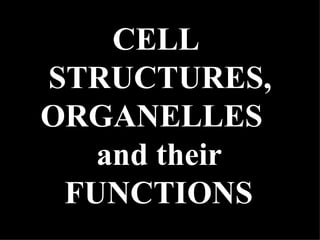
Cell Structure and Organelles: Prokaryotic vs Eukaryotic Cells
- 1. CELL STRUCTURES, ORGANELLES and their FUNCTIONS
- 2. CELL TYPES
- 3. PROKARYOTIC CELLS - Cells that lack a membrane-bound nucleus are called prokaryotes (from the Greek meaning before nuclei). These cells have few internal structures that are distinguishable under a microscope. Cells in the monera kingdom such as bacteria and cyanobacteria (also known as blue-green algae) are prokaryotes. - Prokaryotic cells differ significantly from eukaryotic cells. They don't have a membrane-bound nucleus and instead of having chromosomal DNA, their genetic information is in a circular loop called a plasmid. Bacterial cells are very small, roughly the size of an animal mitochondrion (about 1-2µm in diameter and 10 µm long). Prokaryotic cells feature three major shapes: rod shaped, spherical, and spiral. Instead of going through elaborate replication processes like eukaryotes, bacterial cells divide by binary fission. Diagram of a prokaryotic cell. Notice the internal organelles are not easily distinguishable
- 4. Examples of Prokaryotic Cells:
- 5. EUKARYOTIC CELLS - Eukaryotic cells (from the Greek meaning truly nuclear) comprise all of the life kingdoms except monera. They can be easily distinguished through a membrane-bound nucleus. - Eukaryotic cells also contain many internal membrane-bound structures called organelles. These organelles such as the mitochondrion or chloroplast serve to perform metabolic functions and energy conversion. Other organelles like intracellular filaments provide structural support and cellular motility
- 8. ENDOPLASMIC RETICULUM GOLGI APPARATUS LYSOSOME - Digestive 'plant' for proteins, lipids, and carbohydrates - Transports undigested material to cell membrane for removal - Vary in shape depending on process being carried out - Cell breaks down if lysosome explodes - Protein 'packaging plant' - A membrane structure found near nucleus - Composed of numerous layers forming a sac - Tubular network fused to nuclear membrane - Goes through cytoplasm onto cell membrane - Stores, separates, and serves as cell's transport system - Smooth type: lacks ribosomes - Rough type (pictured): ribosomes embedded in surface
- 9. MITOCHONDRIA VACUOLES RIBOSOMES - Second largest organelle with unique genetic structure - Double-layered outer membrane with inner folds called cristae - Energy-producing chemical reactions take place on cristae - Controls level of water and other materials in cell - Recycles and decomposes proteins, fats, and carbohydrates, and forms urea - Membrane-bound sacs for storage, digestion, and waste removal - Contains water solution - Contractile vacuoles for water removal (in unicellular organisms) - Each cell contains thousands - Miniature 'protein factories' - Composes 25% of cell's mass - Stationary type: embedded in rough endoplasmic reticulum - Mobile type: injects proteins directly into cytoplasm
- 10. SURFACE CELL WALL PLASMA MEMBRANE - Most commonly found in plant cells - Controls turgity - Extracellular structure surrounding plasma membrane - Primary cell wall: extremely elastic - Secondary cell wall: forms around primary cell wall after growth is complete - Outer membrane of cell that controls cellular traffic - Contains proteins (left, gray) that span through the membrane and allow passage of materials - Proteins are surrounded by a phospholipid bi-layer.
